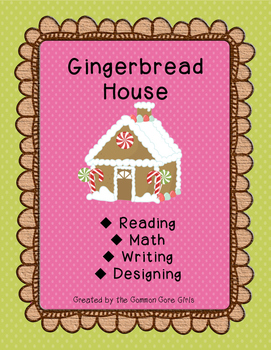Christmas Gingerbread House Project: Reading, Writing, Math, Designing
Common Core Girls
575 Followers
Grade Levels
3rd - 5th
Resource Type
Standards
CCSS3.OA.A.3
CCSS3.OA.B.5
CCSS3.OA.D.9
CCSSRL.3.2
CCSSRL.3.3
Formats Included
- PDF
Pages
23 pages
Common Core Girls
575 Followers
Description
This Common Core activity guides students to build a gingerbread house through a read aloud, note taking, writing, purchasing (math activity), and designing. The teacher uses the read aloud Gingerbread Baby by Jan Brett to teach this step-by-step activity with answer keys.
Students complete a note taking activity after listening to the read aloud, two writing assignments (narrative writing and step-by-step directions), two math problem-solving activities, and a student illustration of their gingerbread house. After the completing the activities and planning, students are ready to build their very own gingerbread house.
*****************************************************************************
Included in this unit for easy planning:
• Step by step teacher directions
• Answer keys
• Parent letter explaining the activity
• Student cover
• Two math problem solving activities
• Note taking graphic organizer with answer key
• Two writing activities
• Narrative story graphic organizer
• Design activity
• Grocery list for supplies
• Classroom management tips
Enjoy this fun, creative, easy to implement, integrated unit!
Other seasonal products you will enjoy:
Magic Tree House Rags and Riches: No Prep Differentiated Instruction
Christmas Memory Narrative Writing Project-Easy prep, Printables
Students complete a note taking activity after listening to the read aloud, two writing assignments (narrative writing and step-by-step directions), two math problem-solving activities, and a student illustration of their gingerbread house. After the completing the activities and planning, students are ready to build their very own gingerbread house.
*****************************************************************************
Included in this unit for easy planning:
• Step by step teacher directions
• Answer keys
• Parent letter explaining the activity
• Student cover
• Two math problem solving activities
• Note taking graphic organizer with answer key
• Two writing activities
• Narrative story graphic organizer
• Design activity
• Grocery list for supplies
• Classroom management tips
Enjoy this fun, creative, easy to implement, integrated unit!
Other seasonal products you will enjoy:
Magic Tree House Rags and Riches: No Prep Differentiated Instruction
Christmas Memory Narrative Writing Project-Easy prep, Printables
Total Pages
23 pages
Answer Key
Included
Teaching Duration
2 Weeks
Report this resource to TPT
Reported resources will be reviewed by our team. Report this resource to let us know if this resource violates TPT’s content guidelines.
Standards
to see state-specific standards (only available in the US).
CCSS3.OA.A.3
Use multiplication and division within 100 to solve word problems in situations involving equal groups, arrays, and measurement quantities, e.g., by using drawings and equations with a symbol for the unknown number to represent the problem.
CCSS3.OA.B.5
Apply properties of operations as strategies to multiply and divide. Examples: If 6 × 4 = 24 is known, then 4 × 6 = 24 is also known. (Commutative property of multiplication.) 3 × 5 × 2 can be found by 3 × 5 = 15, then 15 × 2 = 30, or by 5 × 2 = 10, then 3 × 10 = 30. (Associative property of multiplication.) Knowing that 8 × 5 = 40 and 8 × 2 = 16, one can find 8 × 7 as 8 × (5 + 2) = (8 × 5) + (8 × 2) = 40 + 16 = 56. (Distributive property.)
CCSS3.OA.D.9
Identify arithmetic patterns (including patterns in the addition table or multiplication table), and explain them using properties of operations. For example, observe that 4 times a number is always even, and explain why 4 times a number can be decomposed into two equal addends.
CCSSRL.3.2
Recount stories, including fables, folktales, and myths from diverse cultures; determine the central message, lesson, or moral and explain how it is conveyed through key details in the text.
CCSSRL.3.3
Describe characters in a story (e.g., their traits, motivations, or feelings) and explain how their actions contribute to the sequence of events.





